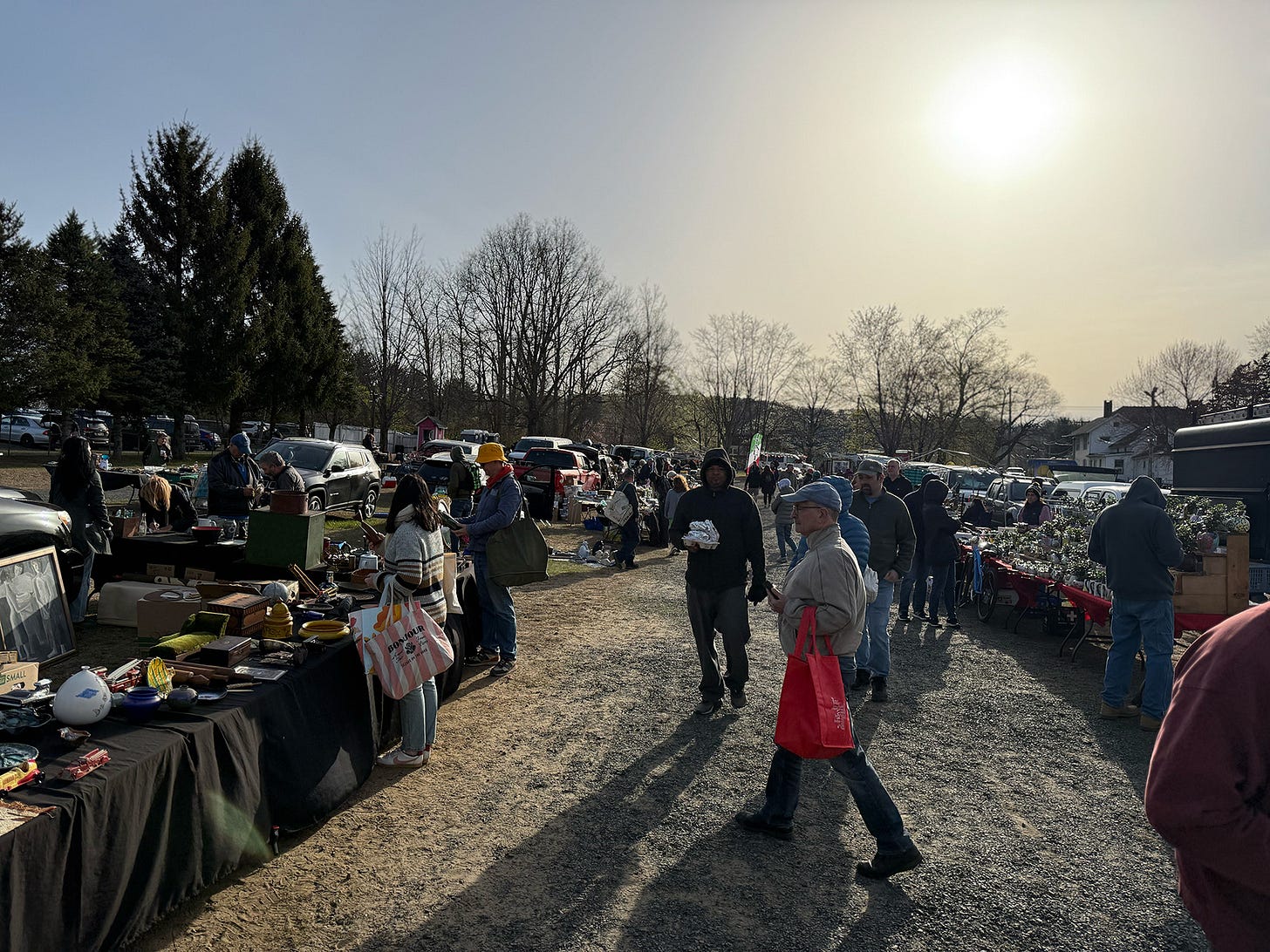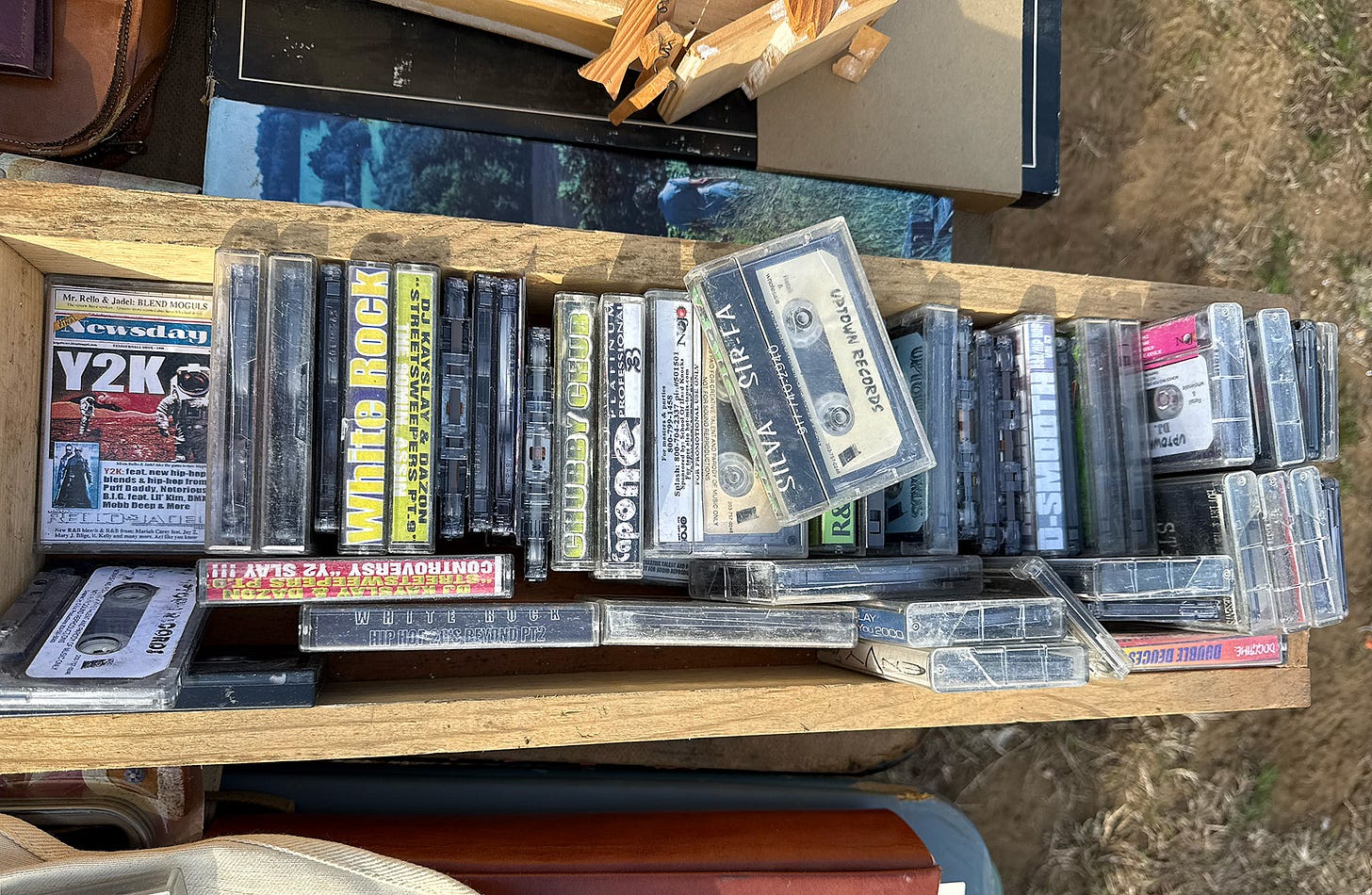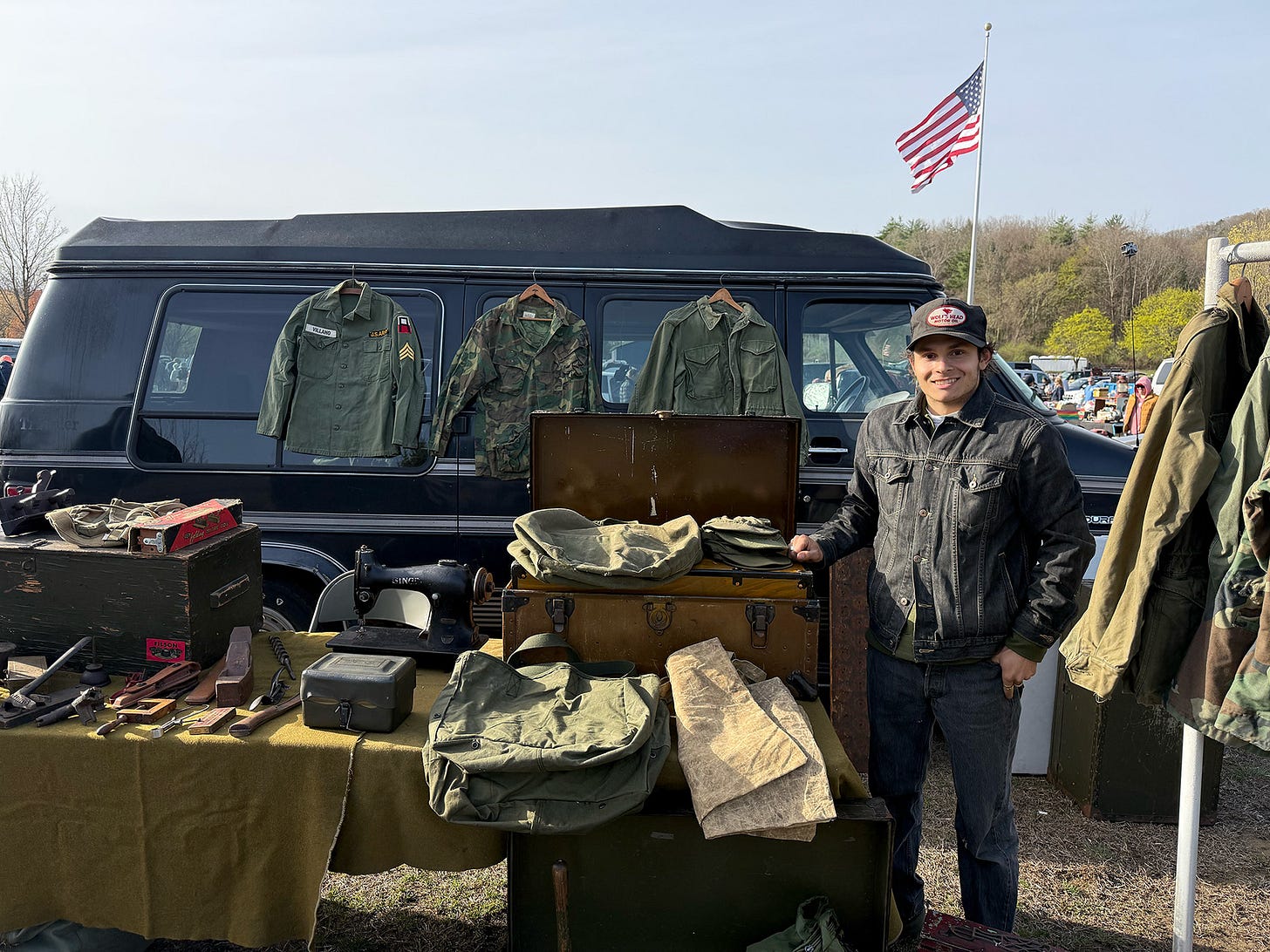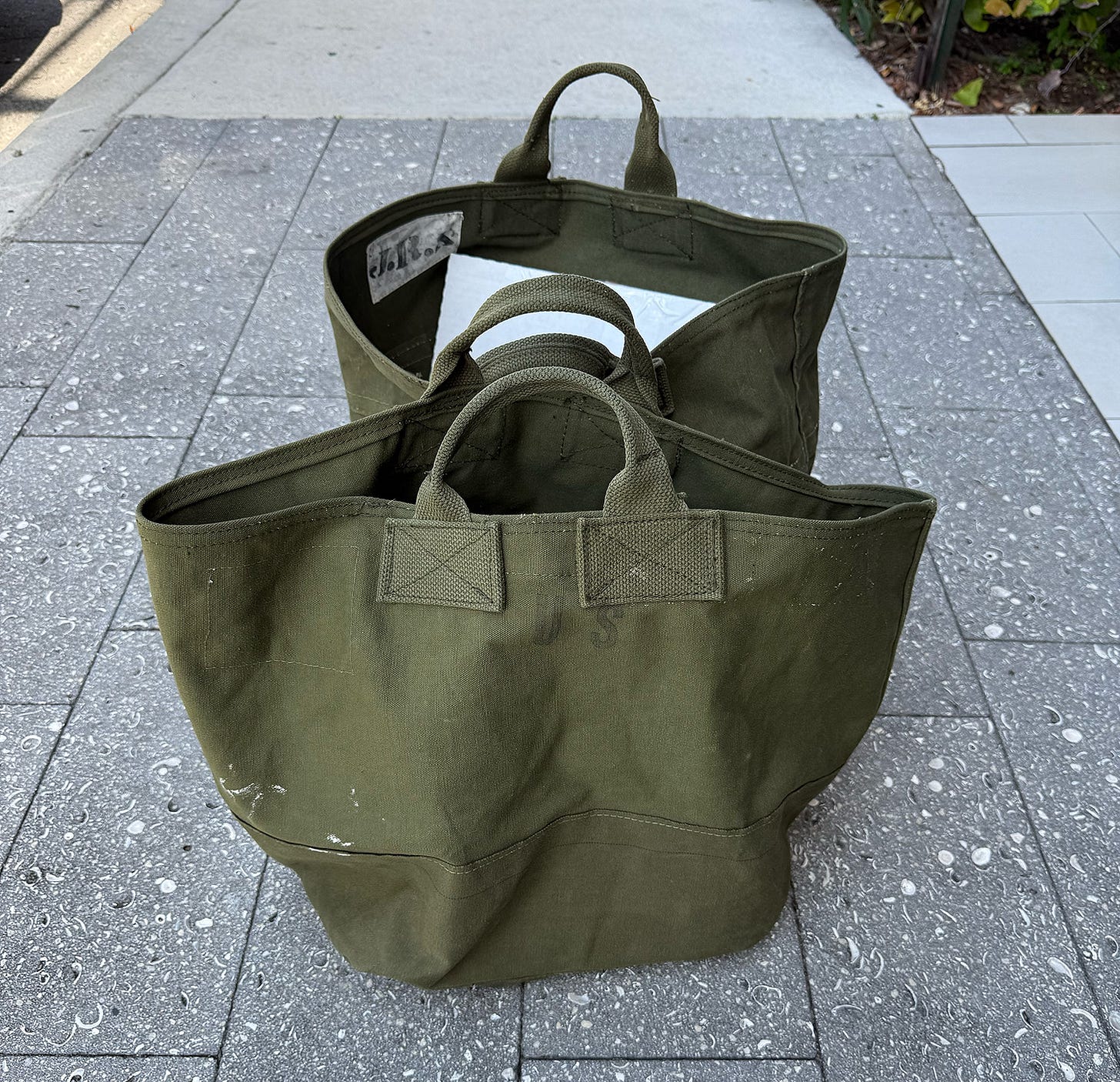Young, Scrappy, and Upcycling: Julian Spaccarelli’s Fresh Take on Surplus Style
A chance encounter at a Connecticut flea market led me to a 21-year-old New York designer reshaping how military fabrics are reused, repurposed, and reimagined.
I only had a four-hour window last Easter Sunday morning for the season opener of the Elephant’s Trunk Show in New Milford, CT. It’s by far one of my favorite New England flea markets — one I frequented often, as it sits right between Brooklyn, NY and Hartford, CT, where my family still lives.
But Easter weekend gave me a short window. At a minimum, I needed an hour each way for travel, which limited my on-field time to a paltry two hours.
It’s risky — me in a field of vintage and old things rarely lasts just two hours. But honestly, my hope was that I wouldn’t find much anyway, because I really didn’t want to lug a lot back to Miami.
But truthfully, opening weekend at Elephant’s Trunk felt quiet. By the time I arrived at 8:00 a.m., the field had already been open for a couple of hours, and vendor attendance was low: about 40% of the field was unoccupied.
For me, this worked out well; with less to see, my two-hour window should be a breeze. Elephant’s Trunk is a manageable flea market, especially compared to Brimfield, with its endless fields and lanes of vintage upon vintage. It’s manageable, and quite frankly, still carries the charm of a field swap — the kind I miss down in South Florida.
People came bundled up, well-prepared to walk, and cash in hand.
One of the great advantages of Elephant’s Trunk is the amount of clothing and military gear that shows up — truck after truck vending bales of vintage clothing and military wear, all at pretty affordable prices.
People come to flea markets to sell, not to head back home with inventory. The whole purpose of the flea is to unload.
That need to part with things is what makes Elephant’s Trunk one of the best for sheer discovery. The number of things you forgot about — or things you didn’t even know existed — are laid out on tables, simply waiting for a look or observation.
I felt that firsthand while going through a box of old alternative gay magazines from New York City. They were packed with flyers and event listings — tremendous artifacts that documented that moment in time.
David Kennerley’s book “Getting In: NYC Club Flyers From the Gay 1990s” does a fantastic job of collecting much of this material, so at this point in my life, I’d rather buy the book than the originals.
And besides, I had no suitcase space and no time to find a place to mail them home.
I also ran across a number of Y2K mixtapes — the kind you’d find sold on New York City streets or in cities with strong tape scenes.
Aside from a couple of names I’m familiar with, I didn’t know enough about these tapes to haul all 50 of them. I actually called a friend around 8:00 a.m. to check if they were worth saving, but it was Easter Sunday — and he’s Puerto Rican, so they celebrate big and don’t worry much about old mixtapes (quite frankly, he probably has them all anyway).
Mixtapes aside, flea markets are also a great place to meet young, new creatives. They’re a fertile ground for small creators making new things out of old things.
Take, for instance, Julian Spaccarelli of Beekman, NY — a small town just 90 minutes north of New York City — who I met selling out of a beautiful 1992 GMC Vandura1 some of the coolest repurposed military tote and shoulder bags.
From a distance, I could see what looked like a reworked U.S. Army cargo bag, the “Duffel Bag, OD Green, USGI Issue” issued to all U.S. Army recruits during boot camp. But these weren’t the long cylindrical styles I was used to seeing; these were modified, or maybe better said as re-worked.
I would call Julian’s creation a tote bag or maybe they are something closer to a tool bag, but without leather handles. The handles, in fact, were original to the U.S. Army duffle bag, but edited with side handles moved up to the hem of the bag, making then both incredibly study and over-engineered like all good tote bag are: if they cannot carry bricks, they are not true totes.
Whatever you call it, it was one of the coolest things I saw all day and I immediately bought two.
With bags in hand, I was now drawn to the maker.
I quickly learned Mr. Spaccarelli was a tradesman — and even more interestingly, at 19, traveled to Italy to train and study in the art of shoe making. Now, I’ve known many who went to Italy to apprentice and learn, but Julian was the first person I had met who went specifically with the intention to learn how to make shoes, or rather sneakers, the Italian way.
Julian is a student of footwear first, and he follows a now well-defined pathway from sneaker culture into fashion and design as a whole. Sneakers remain one of the first touch points many young creatives have with fashion today with even the most limited of editions being easily accessible from the likes of Stock X or eBay.
But Julian is unique in taking that sneaker passion, and the opportunity in Italy, to learn even more. It all basically started because of family. As Julian told me:
I learned about [the school] when I was searching up on Google on how to make sneakers. It was one of the first places that came up. But at first, I didn't know if I really wanted to go, because it was so far away from home, and I've never really traveled that far.
But a little after that, my grandmother told me that she was going to Italy for a couple months, and I decided to go with her, especially since I would have somebody that was gonna be goin.
I even learned that I had some family in the area, and I got to meet them which was pretty cool. And the sneaker school, I got to learn how to make sneakers, how to pattern everything and work with really nice leathers. The other students are pretty cool too.
And just being able to go around Florence and see all the vintage shops there, and being able to see so much history and all the different textiles opened my eyes to more.
Since then, he’s crafted his trade further considering to how take his name, and brand moniker JRS to do more than accessories, furthering into trouser pants and beyond. He’s eager to grown and learn more without a necessary need to do it quickly.
Follow Julian and his J.R.S. brand at @j.spacc.
Find Julian selling his works at Hertans Field Brimfield, MA May 14-18 during opening week.












I have one of jrs’s bags
Absolutely love it
Very unique
Love Elephant Trunk! Yes to all the tapes. What a find.